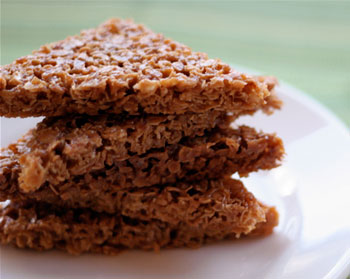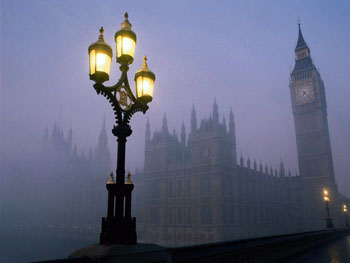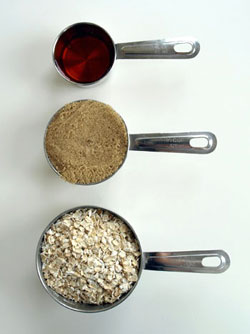 When I was growing up in England in the fifties and sixties, there was a snack called a flapjack that could be occasionally bought at bakeries but was more often found in homes, served up by diligent housewives. It was never found at my home: the only time my mother turned on the stove was to light a cigarette. But some of my friends’ mothers did make them, and the sweet, buttery smell of freshly baked flapjacks is one of those childhood aromas that still haunt me today.
When I was growing up in England in the fifties and sixties, there was a snack called a flapjack that could be occasionally bought at bakeries but was more often found in homes, served up by diligent housewives. It was never found at my home: the only time my mother turned on the stove was to light a cigarette. But some of my friends’ mothers did make them, and the sweet, buttery smell of freshly baked flapjacks is one of those childhood aromas that still haunt me today.
Now, for the American reader a point of clarification is required. British flapjacks bear absolutely no resemblance to American ‘flapjacks’, which seems to be just another word for pancakes. The British flapjack is a unique item unto itself, but if a comparison is required, I suppose a granola bar would come closest in look and texture. But it is simpler, more elemental, only requiring four ingredients (long before Michael Pollan came up with his five ingredient mantra): oats, sugar, butter and golden syrup.
I hadn’t really thought about flapjacks, or more importantly craved them, in about 30 years, which conveniently coincided with my departure from England. Out of sight, out of mind. Also, because flapjacks are to a large extent home made, once I left England they were, quite simply, unavailable. I couldn’t even find them in the local Brit store alongside other weird Brit items like Marmite and Gentleman’s Relish. So here I was, living a carefree, flapjack-free life, when out of the blue, a British friend of mine – who was struggling with a wheat-free diet – mentioned that her mother-in–law had sent her a recipe for flapjacks.
My taste buds immediately perked up.
“Flapjacks !” I exclaimed, trying to control my excitement, “You don’t mean pancakes?”
“No, of course not.” said my friend slightly irritated, “British, flap jacks.”
"Just checking," I replied. After all, we have both lived in America for many years and there are other British affectations, apart from our accents, that we might be losing. Sensing my enthusiasm, she offered to bring me some the next time she made a batch. A week later she dropped by, carrying a 3-inch square flapjack wrapped up in a paper towel. She confessed she had meant to bring me more, but her British husband had consumed the rest.
 From my first bite, à la Proust, I was instantly transported to my childhood in London, circa 1959. Memories of walking back from school with my Italian au pair, me begging to stop at the bakery for a flapjack and she agreeing, as long as we could stop at the nearby Catholic church to light a candle for a long departed relative. Inside the warm bakery, me pointing to a flapjack and a plump rosy woman scooping it up from a large tray and depositing it in a small paper bag and saying, “There you go, luv." Walking home along the gray pavement, trying very carefully not to step on the cracks, lest a monster eat me, clutching my treat. Surrounded by red brick houses, topped off by the gray sky, with leftover fog from a pea-souper, which had virtually imprisoned us in the flat for a couple of days. Carefully nibbling on the crumbly, buttery, oaty square, trying to make it last until we got home. Catching the crumbs in the brown paper bag and licking my fingers to scoop up the gritty remnants.
From my first bite, à la Proust, I was instantly transported to my childhood in London, circa 1959. Memories of walking back from school with my Italian au pair, me begging to stop at the bakery for a flapjack and she agreeing, as long as we could stop at the nearby Catholic church to light a candle for a long departed relative. Inside the warm bakery, me pointing to a flapjack and a plump rosy woman scooping it up from a large tray and depositing it in a small paper bag and saying, “There you go, luv." Walking home along the gray pavement, trying very carefully not to step on the cracks, lest a monster eat me, clutching my treat. Surrounded by red brick houses, topped off by the gray sky, with leftover fog from a pea-souper, which had virtually imprisoned us in the flat for a couple of days. Carefully nibbling on the crumbly, buttery, oaty square, trying to make it last until we got home. Catching the crumbs in the brown paper bag and licking my fingers to scoop up the gritty remnants.
Another bite, and I was transported to a few years later, going to my best friend’s house and being served a plate full of flapjacks and trying to restrain myself from inhaling the entire lot. Another bite, and I remembered being at boarding school, skipping class and sneaking off to the local tea shop to buy a flapjack and being caught by a teacher and trying to hide the incriminating evidence as though it was a bottle of booze or a stash of drugs.
Although today I am a good cook and enjoy cooking, baking has never been my forté. It requires a precision and attention to detail that I lack. But after my flapjack experience, I decided I had to learn how to make these tasty treats. After all, only four ingredients, how hard could it be?
 I called my friend and she reeled off the recipe over the phone. I made it and it was a disaster. Instead of crisp squares, I had created a gooey greasy blob. I called her back; she quickly identified the problem: I had used the wrong kind of oats. Realizing she was working with a baking novice, she told me to text her a photo of the mixture before I put it in the oven so she could tell if the consistency was right.
I called my friend and she reeled off the recipe over the phone. I made it and it was a disaster. Instead of crisp squares, I had created a gooey greasy blob. I called her back; she quickly identified the problem: I had used the wrong kind of oats. Realizing she was working with a baking novice, she told me to text her a photo of the mixture before I put it in the oven so she could tell if the consistency was right.
Ah the marvels of modern technology. A few photos later and the next batch were perfect. I even got bold and added an extra ingredient: pecans.
So now when I feel a bit nostalgic for something British or my British childhood, I whip up a batch of flapjacks. And I have to warn the reader they are highly addictive, even to non-Brits. They also are absurdly easy to make and virtually foolproof. And although they may not exactly be low calorie, they are wheat-free. Enjoy!
British Flapjacks
4 oz salted Butter
1/4 to 1/3 cup of Demerra (golden) sugar. (You can add more if you like them sweeter)
2 tablespoons of Agave syrup or Golden Syrup
1 3/4 cup of Quaker quick oats: not instant or old fashioned. I tried the old fashioned and it was a disaster!
1/4 cup of chopped pecans or anything else you fancy, raisins, choc chips, walnuts, etc.
Pre-heat oven to 350°F.
In a small saucepan over a low heat, mix butter, sugar and syrup until it melts. Stir in oats and nuts. Transfer mixture to well greased 9-inch Pyrex pie plate, or a 6-inch brownie pan.
Put in oven and cook for 25 minutes or until golden brown. Remove from oven, cut into squares and let cool.
Try not to eat entire batch at once.